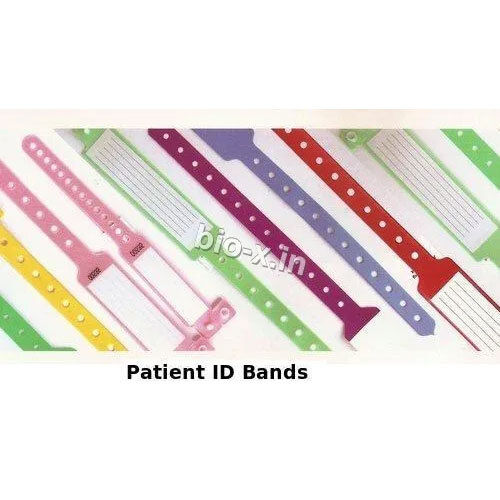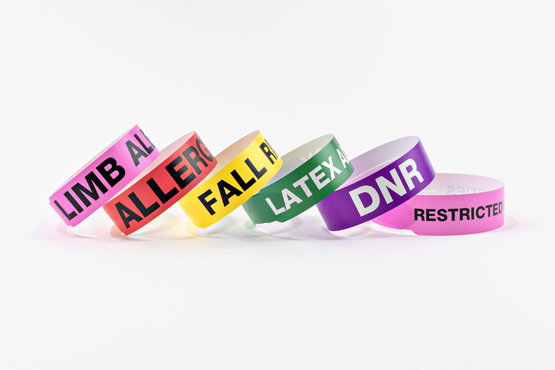Why Every Patient Needs a Reliable Patient Identification Band for Safety
Why Every Patient Needs a Reliable Patient Identification Band for Safety
Blog Article
Exploring the Numerous Kinds Of Patient Identification Band Made Use Of in Medical Facilities
In the elaborate globe of medical care, the vital role of Patient Identification bands usually goes unnoticed. These bands, differing from basic paper wristbands to advanced RFID bands, develop the backbone of Patient safety methods, making certain precision in Patient Identification.
Comprehending the Significance of Patient Identification Bands
While they may appear like mere devices, Patient Identification bands play an essential duty in clinical facilities. These bands work as a crucial tool for confirming Patient identity, preventing clinical errors associated to misidentification. The bands generally show vital info such as the Patient's name, age, blood kind, and any kind of known allergies. They enable medical care specialists to rapidly access this important information, thereby facilitating accurate and punctual clinical therapy. Patient Identification bands likewise aid in simplifying management tasks, guaranteeing precise record-keeping and payment. Despite their simpleness, these bands symbolize the principle of Patient security, a keystone of quality healthcare. Without them, the risk of medical errors, and consequently, Patient damage, may dramatically increase.
Conventional Paper Wristbands: Their Use and Limitations
Traditional paper wristbands have actually been a staple in Patient Identification across various medical facilities. While their use is prevalent, they harbor specific restrictions that may impact their efficiency in Patient management. This area will certainly focus on the scope of their application and the inherent downsides connected with their use.
Paper Wristbands: Usage Extent
In the world of Patient Identification, paper wristbands have long held a crucial function. These bands are generally made use of in outpatient settings, where the Patient's keep is momentary. The wristbands include essential info such as the Patient's name, date of birth, and an unique Identification number. This simple, yet efficient system, allows physician to promptly and accurately identify people, making sure the proper therapy is carried out. Paper wristbands are additionally utilized in emergency situation circumstances, where rapid Identification is vital. Their usage reaches events like blood contribution drives and mass vaccination programs, further stressing their versatility. Regardless of improvements in modern technology, the humble paper wristband continues to be a trusted and economical solution for Patient Identification in numerous healthcare situations.
Limitations of Paper Wristbands
In spite of their widespread use, paper wristbands are not without their disadvantages. In enhancement, paper wristbands often do not have the technological capabilities of more modern choices, such as barcoding or RFID chips, limiting their capability to simply presenting composed info. Paper wristbands can trigger pain or skin inflammation to some patients, particularly when worn for prolonged durations.
Barcoded Wristbands: Improvements in Patient Identification
While Patient Identification has long been an essential aspect of healthcare, the introduction of barcoded wristbands symbolizes a substantial jump ahead. These bands take advantage of the simpleness of barcoding innovation, enabling for Patient info to be swiftly checked and accessed. They improve the speed and accuracy of Patient Identification, reducing the threat of clinical mistakes connected to misidentification.
Radio Regularity Identification (RFID) Bands: a Step Towards Futuristic Medical Care
The advancement of Patient Identification bands has produced the development over at this website of Radio Regularity Identification (RFID) Bands (patient identification band). These ingenious devices present key benefits for medical care centers, providing a more effective and technologically advanced methods of Patient Identification. The execution of RFID in medical care is a considerable step towards an extra advanced method to Patient monitoring and security
Comprehending RFID Bands

RFID Bands: Trick Advantages
Embracing a future where technology and healthcare merge, radio frequency Identification bands use numerous crucial advantages. Primarily, these bands boost Patient security by offering accurate, rapid Identification, consequently minimizing medical errors. RFID bands can save a substantial amount of Patient information, including medical background and allergic reactions, enabling individualized treatment. They additionally enhance administrative jobs, as the automated data entrance replaces hand-operated processes, improving performance and lowering documents. Moreover, RFID bands provide real-time monitoring of individuals, essential in high-risk settings such as surgical treatment or intensive care. Finally, these bands are resilient and immune to environmental aspects, making sure consistent performance. On the whole, RFID bands represent a substantial innovation in Patient Identification modern technology, benefiting both individuals and doctor.
Implementing RFID in Medical Care
As we tip into a technically sophisticated age, the his response implementation of RFID bands in medical care becomes significantly vital. These bands supply a seamless way to track and determine patients, guaranteeing their safety and enhancing effectiveness in treatment procedures. RFID bands provide various advantages over traditional Identification approaches. They can store a large amount of data, consisting of the Patient's clinical history and treatment strategies, which can be conveniently accessed by health care service providers. This information helps medical professionals make notified decisions pertaining to the Patient's therapy strategy. Moreover, RFID bands minimize medical errors by giving precise Patient Identification, which is critical in stopping misdiagnosis or wrong medication management. Therefore, the implementation of RFID bands is a significant action towards boosting Patient safety and medical care shipment.

Color-Coded Wristbands: Aiding in Quick and Accurate Medical Diagnosis
In the busy environment of a medical center, color-coded wristbands have emerged as essential tools for swift and exact Identification of an individual's medical problem. These wristbands, put on by people, carry particular colors that match to different clinical conditions or statuses. This system is made to provide immediate visual hints to medical care providers, improving Patient safety and security and care top quality.
Approaches for Reliable Implementation and Management of Patient ID Bands
Accomplishing optimal usage of Patient Identification bands demands a well-structured technique for their implementation and management. Patient education is also critical; individuals should recognize the view it now function of the bands and the need for their consistent wear. It's necessary to have a backup plan in location, such as barcode scanning or biometrics, to guarantee that Patient Identification is never ever jeopardized.
Conclusion
Patient Identification bands are critical in clinical centers to ensure security and accuracy. Efficient execution and administration of these bands can substantially decrease medical mistakes, boost efficiency, and boost general Patient care.
These bands, differing from straightforward paper wristbands to sophisticated RFID bands, develop the foundation of Patient safety and security procedures, ensuring accuracy in Patient Identification.The development of Patient Identification bands has brought concerning the emergence of Radio Frequency Identification (RFID) Bands. Generally, RFID bands stand for a significant innovation in Patient Identification innovation, benefiting both clients and health care service providers.
RFID bands minimize clinical errors by giving precise Patient Identification, which is important in stopping misdiagnosis or wrong medication administration. Patient education is additionally important; clients need to understand the objective of the bands and the demand for their constant wear.
Report this page